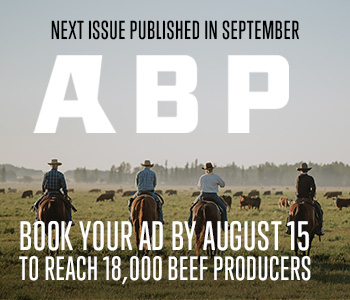AB Direct - Steers
Rail: 495.00-500.00 del
AB Direct - Heifers
Rail: 495.00-500.00 del
US Trade- Steers
Rail: ---
US Trade - Heifers
Rail: ---
Canadian Dollar
0.12
Thinking about alternative feed sources? Think outside the box
After facing a third year of drought across much of Alberta, producers are getting creative in the search for alternative feed options. Here are some ideas to help beef cattle survive – if not thrive – through another difficult year.
Continuing dry weather is translating into a tight feed supply again this fall. By mid-August, some producers were already feeding cows, three to four months earlier than in a good year. Lynne Girardin, ruminant nutritionist with BeefSmart, suggests using creativity and ingenuity to source alternative feed.
“If you can bale it or put a fence around it, we can test it to make sure there are no toxins and the nutrients aren’t out of whack for the class of cattle, and they can feed on it. We’ve been feeding almost everything under the sun,” she says.
Think through all options
A quick list of feed options includes: cereals, including wheat, barley, and oats; legumes, both peas and lentils; and brassicas, including canola regrowth (if sulfur levels are acceptable). Creative producers are also having success feeding animals hailed-out or failed annual cash crops, crop stubble and weeds such as kochia.
Girardin says, “Cattle are amazing at taking lower quality feed and turning it into energy and protein, and not just surviving on it but thriving.”
Another option is fencing new areas for pasture. “I’m testing slough bottoms and marsh areas, and new fences are getting put around areas that have never been grazed before. We first walk through new pastures and see what’s in there to make sure nothing will hurt grazing animals. As long as we know what we’re dealing with in terms of nutrient composition and toxins, we can feed almost anything,” Girardin says.
Ask around
Checking in with other farmers and food producers may pay off, especially if you have contacts who farm in areas that received more rain this year. “They may have more feed available than they need, or in some cases producers sold their own cows but still have pasture available,” Girardin says.
Of course, there’s a nutrient-cycling benefit for landowners who allow cattle to graze their land, Girardin points out. “Any manure and urine left behind while the cattle are out there is like free fertilizer, so that’s a good concept to sell to your neighbours.”
Test first
The preliminary step in using alternative feed sources or pastures is to test for toxins, such as ergot, fusarium, DON, and particularly nitrates, which can be high in drought-stressed feeds. “Nitrates can be present at any growth stage, so that’s an important one to watch out for. Another common toxin is oxalate in weeds, and it’s important to test for, because it can be very toxic to cattle,” says Girardin.
When cattle are feeding in new areas, be sure to test water sources and slough bottoms. “Green algae problems generally occur a lot earlier in the year in water sources, but anytime we have a change in temperature or lengthy period of drought, well water properties and nutrients can change. The key is to test everything the animals might be eating or drinking so you know what you’re dealing with,” Girardin says.
Get help to do-it-yourself
Nutritionists are available to help with testing, but aren’t essential. “In a drought period, producers are already stressed for cash, so they may prefer to do all the necessary testing on their own to avoid extra costs,” says Girardin.
To do it yourself, start with good information. The Beef Cattle Research Council (BCRC) website offers great feed testing information as a starting point, and a ruminant nutritionist or feed company salesperson may be able to answer questions.
The key, suggests Girardin, is to start by testing a representative sample. “Ensure your tests will give you the results you need to make a good decision in the first place, so you don’t end up having to make a difficult decision later.”
Considering the many alternative feed sources available is wise even in good years, because it extends grazing time, Girardin says. “It allows producers to reserve their best feed supply for when it’s most needed, and it has kept many from having to sell the herd. There are multiple options available; we just have to think outside the box.”
This article was first published in Volume 3 Issue 3 of ABP Magazine (September 2023). Watch for more digital content from the magazine on ABP Daily.


